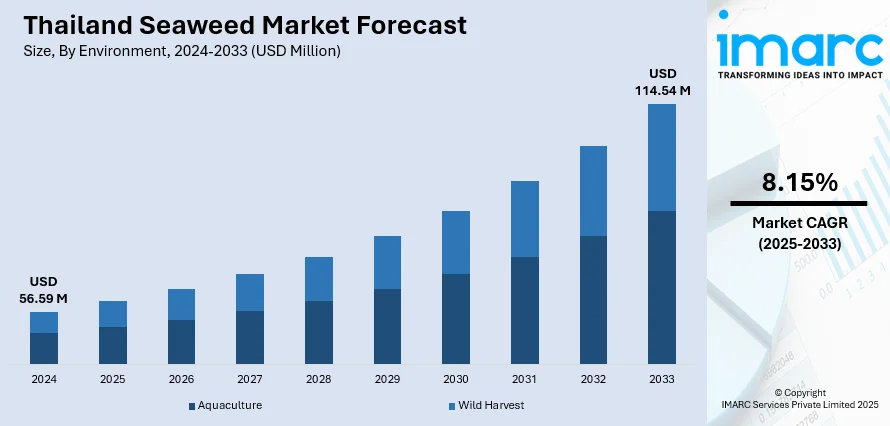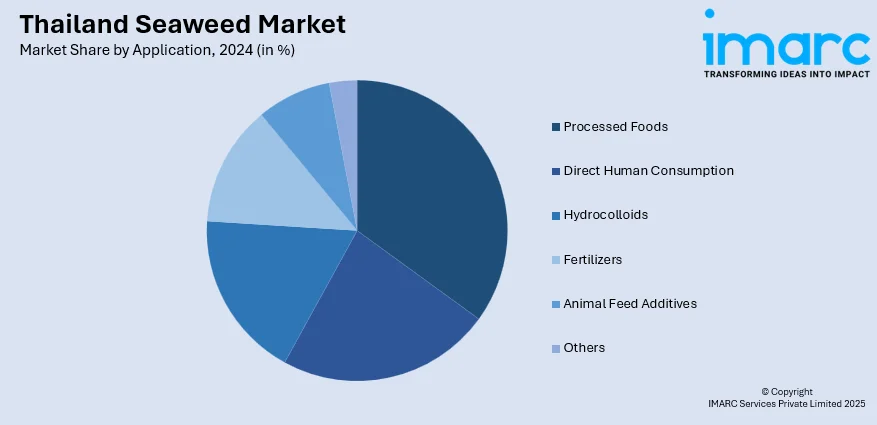
Thailand Seaweed Market Size, Share, Trends and Forecast by Environment, Product, Application, and Region, 2025-2033
Thailand Seaweed Market Overview:
The Thailand seaweed market size reached USD 56.59 Million in 2024. Looking forward, IMARC Group expects the market to reach USD 114.54 Million by 2033, exhibiting a growth rate (CAGR) of 8.15% during 2025-2033. Rising demand for plant-based foods, government support for marine aquaculture, growing export potential, health benefits of seaweed-based products, increasing industrial applications, and local cultivation initiatives are some of the factors contributing to Thailand seaweed market share. Expanding consumer awareness and innovation in food processing are also contributing to market expansion.
|
Report Attribute
|
Key Statistics
|
|---|---|
|
Base Year
|
2024 |
|
Forecast Years
|
2025-2033
|
|
Historical Years
|
2019-2024
|
| Market Size in 2024 | USD 56.59 Million |
| Market Forecast in 2033 | USD 114.54 Million |
| Market Growth Rate 2025-2033 | 8.15% |
Thailand Seaweed Market Trends:
Strengthening Resilience and Sustainability in Seaweed Cultivation
Thailand is gaining renewed attention in regional seaweed farming through a new international collaboration aimed at boosting biosecurity and minimizing disease outbreaks. This approach is especially relevant as climate variability puts added pressure on aquatic crops. The project focuses on making cultivation more resilient and sustainable by working directly with Thai academic and development partners. Local livelihoods and marine ecosystems stand to benefit from this effort, which is positioned to bring new research, monitoring, and disease management strategies into the field. Backed by a UK research body and regional institutions, the initiative brings new energy to a sector with economic potential, especially for coastal communities that rely on seaweed farming as a primary or supplemental income. These factors are intensifying the Thailand seaweed market growth. For example, in April 2025, the Natural History Museum launched GLOBALSEAWEED-Protect, a UKRI-funded project to strengthen Southeast Asia’s seaweed sector. With Thailand as a key regional player, the initiative aims to boost biosecurity, combat crop disease, and improve climate resilience. The three-year effort would support local livelihoods and biodiversity, working with institutions across the region, including Kasetsart University and Yunus Thailand.

To get more information on this market, Request Sample
Empowering Coastal Women through Sustainable Caulerpa Farming
In southern Thailand, Caulerpa farming is creating new income opportunities for women in low-income coastal communities. A grassroots project in Satun Province is equipping participants with farming kits and hands-on training to grow this high-demand seaweed sustainably. The approach isn’t just about farming, it’s helping women increase their earnings and self-reliance. Interest is growing, with plans underway to involve more communities and introduce processed seaweed products. This signals a practical move toward fairer and more eco-conscious aquaculture, where small producers and coastal households play a central role. As the model scales, it’s shaping a more inclusive direction for Thailand’s seaweed cultivation, where economic empowerment and environmental care go hand in hand. For instance, in January 2025, Yunus Thailand launched a Seaweed Social Business project in Satun Province to empower low-income women through sustainable Caulerpa seaweed farming. The initiative provides training and farming kits, helping participants boost income and confidence. With growing interest, the project plans to expand by developing value-added products and engaging more communities. It marks a shift in Thailand’s seaweed sector toward inclusive, environmentally friendly practices that support local livelihoods and coastal sustainability.
Thailand Seaweed Market Segmentation:
IMARC Group provides an analysis of the key trends in each segment of the market, along with forecasts at the regional level for 2025-2033. Our report has categorized the market based on environment, product, and application.
Environment Insights:
- Aquaculture
- Wild Harvest
The report has provided a detailed breakup and analysis of the market based on the environment. This includes aquaculture and wild harvest.
Product Insights:
- Red
- Brown
- Green
A detailed breakup and analysis of the market based on the product have also been provided in the report. This includes red, brown, and green.
Application Insights:

- Processed Foods
- Direct Human Consumption
- Hydrocolloids
- Fertilizers
- Animal Feed Additives
- Others
A detailed breakup and analysis of the market based on the application have also been provided in the report. This includes processed foods, direct human consumption, hydrocolloids, fertilizers, animal feed additives, and others.
Regional Insights:
- Bangkok
- Eastern
- Northeastern
- Southern
- Northern
- Others
The report has also provided a comprehensive analysis of all the major regional markets, which include Bangkok, Eastern, Northeastern, Southern, Northern, and others.
Competitive Landscape:
The market research report has also provided a comprehensive analysis of the competitive landscape. Competitive analysis such as market structure, key player positioning, top winning strategies, competitive dashboard, and company evaluation quadrant has been covered in the report. Also, detailed profiles of all major companies have been provided.
Thailand Seaweed Market News:
- In June 2025, the first Seagriculture World conference was announced to be held in Bangkok, Thailand, in 2026, marking a major step for the country's seaweed sector. Organized by DLG Benelux, the event reflects Thailand's growing role in global seaweed production. It will include site visits, expert sessions on science, business, and regulations, plus a trade expo, reinforcing Thailand’s importance in the international seaweed industry.
Thailand Seaweed Market Report Coverage:
| Report Features | Details |
|---|---|
| Base Year of the Analysis | 2024 |
| Historical Period | 2019-2024 |
| Forecast Period | 2025-2033 |
| Units | Million USD |
| Scope of the Report |
Exploration of Historical Trends and Market Outlook, Industry Catalysts and Challenges, Segment-Wise Historical and Future Market Assessment:
|
| Environments Covered | Aquaculture, Wild Harvest |
| Products Covered | Red, Brown, Green |
| Applications Covered | Processed Foods, Direct Human Consumption, Hydrocolloids, Fertilizers, Animal Feed Additives, Others |
| Regions Covered | Bangkok, Eastern, Northeastern, Southern, Northern, Others |
| Customization Scope | 10% Free Customization |
| Post-Sale Analyst Support | 10-12 Weeks |
| Delivery Format | PDF and Excel through Email (We can also provide the editable version of the report in PPT/Word format on special request) |
Key Questions Answered in This Report:
- How has the Thailand seaweed market performed so far and how will it perform in the coming years?
- What is the breakup of the Thailand seaweed market on the basis of environment?
- What is the breakup of the Thailand seaweed market on the basis of product?
- What is the breakup of the Thailand seaweed market on the basis of application?
- What is the breakup of the Thailand seaweed market on the basis of region?
- What are the various stages in the value chain of the Thailand seaweed market?
- What are the key driving factors and challenges in the Thailand seaweed market?
- What is the structure of the Thailand seaweed market and who are the key players?
- What is the degree of competition in the Thailand seaweed market?
Key Benefits for Stakeholders:
- IMARC’s industry report offers a comprehensive quantitative analysis of various market segments, historical and current market trends, market forecasts, and dynamics of the Thailand seaweed market from 2019-2033.
- The research report provides the latest information on the market drivers, challenges, and opportunities in the Thailand seaweed market.
- Porter's five forces analysis assist stakeholders in assessing the impact of new entrants, competitive rivalry, supplier power, buyer power, and the threat of substitution. It helps stakeholders to analyze the level of competition within the Thailand seaweed industry and its attractiveness.
- Competitive landscape allows stakeholders to understand their competitive environment and provides an insight into the current positions of key players in the market.
Need more help?
- Speak to our experienced analysts for insights on the current market scenarios.
- Include additional segments and countries to customize the report as per your requirement.
- Gain an unparalleled competitive advantage in your domain by understanding how to utilize the report and positively impacting your operations and revenue.
- For further assistance, please connect with our analysts.
 Request Customization
Request Customization
 Speak to an Analyst
Speak to an Analyst
 Request Brochure
Request Brochure
 Inquire Before Buying
Inquire Before Buying




.webp)




.webp)












